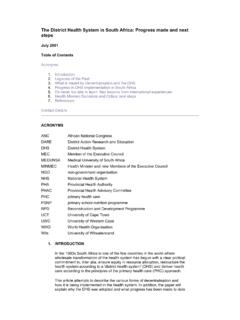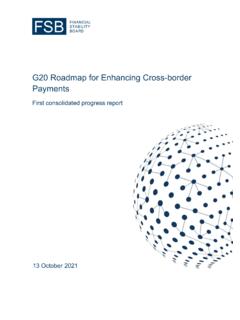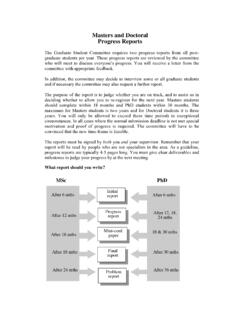Transcription of Progress Report Examples - University of Toronto
1 ECE496Y Progress Report Examples Updated June 2010 1 Progress Report Examples The following Examples are drawn from past student reports, and illustrate how the general guidelines can be applied to a variety of design projects. The technical details have been removed in order to highlight the Report structure and organization as opposed to the technical content or writing style. These Examples have not been properly formatted with the appropriate use of tables, bullets, etc. It is expected that you do not use these as templates, but make the Progress Report suit your project. Note that the Examples follow an older reporting style, where there was no group document.
2 Example #1: Controller for Frequency Modulated Spectroscopy Executive Summary This project involves building a system that modulates light in the to 50kHz range and detects the reflected light through the patient s tissue at multiple distances. This will be accomplished by three main modules: .. To date, the .. modules have been built as planned and are now awaiting .. for integration testing. Particularly, my main contributions However, the X Module, which was originally outside the scope of our current project, was delayed Without this setup, the .. cannot be fully tested for noise tolerance and .. As a result, Kevin and I must now shift our focus completely to the.
3 Several key tasks We plan to complete all these tasks Despite the current difficulties, we will strive to complete the design of a single detection channel to demonstrate the potential of the instrument through the characterization of both the signals and noise in .. 1. Group Progress Summary Summary of Project Goal This project involves building a ..A system block diagram of the proposed technical solution for this device is shown in Figure 1. ECE496Y Progress Report Examples Updated June 2010 2 Figure 1: System block diagram of Frequency Modulated Reflectance Spectroscopy Instrument Summary of Group Progress An overview of the Progress was highlighted in Figure 1 (Blue: Completed, Yellow: In Progress , Red: Delayed).
4 The Progress for each of the six stages is summarized below: Since the design review, the key responsibilities for William included: .. For Kevin, the key responsibilities Summary of Changes As a result of the departure of the research assistant, the optoelectronic module was not ready as planned and the PCB layout was also delayed. This has caused delays in Stage 3 .. To resolve this issue, we have now taken on .. 2. Individual Progress Overview of Contributions My main contributions to the project following list provides an overview of my key contributions: 1) USB Microcontroller Setup and Testing (Appendix C) 2) Designed a refined FFT Model in DSP Builder (Appendix D) 3) Developed the GUI using Borland C++ Builder (Appendix E).
5 4) Verified PCB layout (Appendix F) ECE496Y Progress Report Examples Updated June 2010 3 Table 2: Summary of Individual Milestones for the Current Reporting Period Report on Individual Tasks This section describes the details of the Progress for each task listed (Discussion of Individual Tasks for Stage 2, 4 and 5 have been removed) ECE496Y Progress Report Examples Updated June 2010 4 ECE496Y Progress Report Examples Updated June 2010 5 ECE496Y Progress Report Examples Updated June 2010 6 3. Progress Assessment Our team has completed the GUI and signal processing modules on , the departure of the research assistant has meant that we now need to shift our focus to the optoelectronics Future delays would be expected in the PCB layout due to this departure and the necessary shift in focus.
6 Despite the current difficulties, we are certain that we can complete the design of the single detection channel .. This will allow us to demonstrate the potential of the instrument and understand the nature of both the biological signals and noise present in this system. If the PCB can be manufactured on time, we can also finish the 16-channel design to show the full potential of the instrument. 4. References Appendix A: Revised Gantt Chart Original Gantt Chart .. Appendix B Project Goals and Requirements .. ECE496Y Progress Report Examples Updated June 2010 7 Appendix C: USB Microcontroller Setup ECE496Y Progress Report Examples Updated June 2010 8 Appendix D: Refined FFT Model Figure D1: Refined FFT Model built using DSP Builder (integrated into Simulink).
7 The key to the refined model was the assumption that the signal will not change its frequency after passing through the patient s tissue. This allows the extraction of a specific frequency component without any complex signal processing schemes to locate the peaks in the FFT magnitude plot. The circle encloses the major custom designed blocks. ECE496Y Progress Report Examples Updated June 2010 9 Figure D3: Demonstration of the operation of the New FFT Model in simulation. The input to the model is a sine wave with an amplitude of 32767 (which is equal to 2^16-1 divided by 2). Note that this amplitude corresponds to the maximum swing in the 16-bit input from the 16-bit A/D converter.
8 No negative values are expected since the analog signal corresponds to the light intensity, which is always positive. The output, called FFT_Ans, shows the amplitude extracted from the FFT magnitude plot. The value, 32766, is very close to the expected amplitude. The imprecision is the result of finite arithmetic precision in the digital signal processing blocks used. ECE496Y Progress Report Examples Updated June 2010 10 Example #2: Secure watermark-based authentication system Executive Summary Significant Progress has been made to date in realizing our final project goal. As a group we have accomplished the following: Designed overall user interface structure for.
9 made significant Progress in integrating .. I was solely responsible for a number of the tasks, all of which are now completed, or in Progress . One such task was the design and implementation of .. I decided that it would be best to display the PSNR values caused based on the assumption that our users will have a fair amount of technical knowledge. I also conducted various tests of the signal processing code to .., and was able to I decided to create .. This enabled me to perform various attacks on numerous images and see the results on one screen, which I found to be the most efficient way of testing the operation of the .. One of the problems we encountered and are currently investigating is that we are only able In addition, we have not yet determined how to enable.
10 1. Group Progress Summary The goal of our project remains the same that is, to design a user-friendly interface that makes use of our authentication and verification algorithms for a secure watermark-based digital authentication system. All of our requirements, detailed in Appendix B, have remained unchanged, and since the design review we have made significant Progress in most of our requirements. Some of our key accomplishments since the design review have been: <bulleted list of accomplishments> In order to accomplish the above tasks our key challenge was .. Another challenge was .. Our group is currently on schedule. Some of the milestones (tasks #10, 11 and 12) had to be postponed, but.








